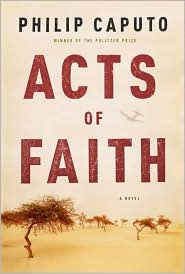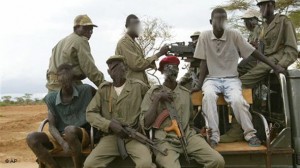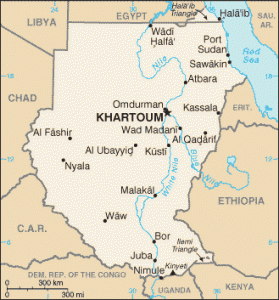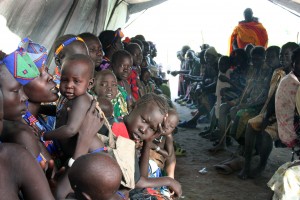“You have in one valley a village and you have in another valley another village and the people don’t even speak the same language. This makes it easy for the Arabs to give rewards to one tribe if they will join with the government. Yes, I’m sorry to report that many Nubans have been bribed to fight against their own people….Tribalism is the problem here, in all Sudan, in all of Africa. Who brought the first African slaves to the slave ships? Other Africans.”
Se tting his massive, almost 700-page novel in Sudan and neighboring Kenya, Philip Caputo details the extraordinary efforts of non-government organizations (NGOs) from around the world to bring aid into “no-go” zones, those zones declared so dangerous that the UN will not enter. Many of these agencies ferry aid through the use of bush pilots and small airlines from Kenya, which fly into Sudan and land on hidden, usually make-shift, landing strips, often dodging small-arms fire and enemy aircraft when they try to return home. The Muslim government of Sudan, located to the north in Khartoum, has long been at war with the oil-rich, largely Christian south, and atrocities occur on a regular basis—the abduction of children for children’s armies, the rape and enslavement of women, the maiming and mutilation of the healthy, the cutting off of food and water, and the theft of medical supplies to prevent disease. Lacking weapons and ammunition, the rebel Sudanese People’s Liberation Army (SPLA) is no match for the heavily supplied army from Khartoum.
tting his massive, almost 700-page novel in Sudan and neighboring Kenya, Philip Caputo details the extraordinary efforts of non-government organizations (NGOs) from around the world to bring aid into “no-go” zones, those zones declared so dangerous that the UN will not enter. Many of these agencies ferry aid through the use of bush pilots and small airlines from Kenya, which fly into Sudan and land on hidden, usually make-shift, landing strips, often dodging small-arms fire and enemy aircraft when they try to return home. The Muslim government of Sudan, located to the north in Khartoum, has long been at war with the oil-rich, largely Christian south, and atrocities occur on a regular basis—the abduction of children for children’s armies, the rape and enslavement of women, the maiming and mutilation of the healthy, the cutting off of food and water, and the theft of medical supplies to prevent disease. Lacking weapons and ammunition, the rebel Sudanese People’s Liberation Army (SPLA) is no match for the heavily supplied army from Khartoum.

Caputo’s large cast of characters consists of the people who participate in the relief of Nuba, an oil-rich area in Sudan—Christian evangelists who bring aid and, through their missionaries, wish to convert the inhabitants; the International People’s Aid group, a humanitarian group from Canada, run by a former Catholic priest and supported by Kenyan philanthropists; German Emergency Doctors, which operates an understaffed and undersupplied local hospital; the mercenary pilots of small airlines which service the area and compete for business; and the shady owners of some of these airlines—along with members of the SPLA; a local Arab warlord allied with the Khartoum government; and members of the international press, most notably CNN.
Caputo’s intentions are to publicize the horror of this Sudanese civil war within a comprehensive novel, which also depicts the local population and the effects of the well-meaning aid workers upon its society. But he also wants to show that “In Sudan the choice is never between the right thing and the wrong thing but between what is necessary and what isn’t…In Sudan the necessary thing IS the right thing,” an ethical conundrum which gives the lie to absolute, conventional values. Planes flying aid are sometimes used to smuggle weapons; the desire to save lives on a massive scale sometimes involves the sacrifice of lives on a small scale.
The action is generated by ch aracters who fly for Knight Air out of Kenya—Fitzhugh Martin, a mixed race Kenyan; Douglas Braithwaite, an American entrepreneur and pilot; and Wesley Dare, a Texas mercenary—along with their lovers, an Anglo-Kenyan philanthropist and a female Canadian pilot. A young female evangelical from Iowa, working in Sudan, becomes part of a third love story when she is attracted to a member of the SPLA.
aracters who fly for Knight Air out of Kenya—Fitzhugh Martin, a mixed race Kenyan; Douglas Braithwaite, an American entrepreneur and pilot; and Wesley Dare, a Texas mercenary—along with their lovers, an Anglo-Kenyan philanthropist and a female Canadian pilot. A young female evangelical from Iowa, working in Sudan, becomes part of a third love story when she is attracted to a member of the SPLA.
The novel does not have a single focus. Instead, the author chooses a three-part focus—on the real atrocities of war and the real corruption of the Sudanese (and, not incidentally, the Kenyan) government; on the real, marginal lives, and the real tribal and religious conflicts of Sudanese people; and on the fictional lives, backgrounds, and relationships of the characters who drive the action of this novel. The lack of a single focus and the attempt to broaden the scope to include everyone who has a stake in Sudan leads to a very long, and “loose” novel. The fictional struggles and love stories of the aid workers and western do-gooders who wish to be a part of the solution in Sudan are given as much emphasis as the cultural and religious battles waged by the very real Sudanese.

Almost seven hundred pages long–with many of these pages devoted to providing detailed background information about the fictional characters (and even their parents)–the novel attempts to explain why they came to Africa, what they hope to accomplish, and what motivates them. The characters are people of action and impulse, however, not of thought and contemplation, and it is their actions, not their thinking, which drive the novel. Judicious editing of fictional backgrounds, especially at the beginning, could have shortened the novel significantly, tightened it thematically, and improved it dramatically.
The three love stories draw in the reader and keep the interest high, but they do dilute the impact of the war and atrocities in Sudan.
Caputo has a dark vision of man’s inner nature. When even a high-minded evangelical makes expedient decisions with horrifying results, and when intense love sputters out, then what is left? Caputo does not provide those answers, nor does the structure of the novel. In a conclusion dependent upon coincidence and melodrama, the reader is left with the idea that in this complex conflict between good and evil, the best one can hope for is a toss-up.
of man’s inner nature. When even a high-minded evangelical makes expedient decisions with horrifying results, and when intense love sputters out, then what is left? Caputo does not provide those answers, nor does the structure of the novel. In a conclusion dependent upon coincidence and melodrama, the reader is left with the idea that in this complex conflict between good and evil, the best one can hope for is a toss-up.
Notes: I must confess that when I tried to find photos to illustrate this review, the photos I found were so searing and so heart-rending, that I couldn’t find many that I could even post here. If you want to know exactly what is happening in the southern Sudan, just go to Google or Yahoo and enter “south Sudan images.” Be aware that what you will see represents the worst of starvation, especially as it affects children.
The author’s photo appears on his RandomHouse author page: http://www.randomhouse.com
The poorly equipped Sudanese People’s Liberation Army tries to fight well-equipped forces from Khartoum, sometimes using boy soldiers: http://www.dw-world.de
The map of Sudan is from http://www.ndlcms.org/
